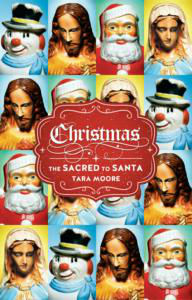Authors explore theological, populist roots of Christmas traditions
"Joy to the World: How Christ's Coming Changed Everything (and Still Does)" by Scott Hahn. Image (New York, 2014). 192 pp., $23.
"Christmas: The Sacred to Santa" by Tara Moore. Reaktion Books (London, 2014). 224 pp., $30.
In his slim volume, "Joy to the World," Scott Hahn -- a former Presbyterian who has become one of today's most prominent Catholic authors, professor of theology and Scripture at Franciscan University of Steubenville, Ohio, and McEssy distinguished visiting professor in biblical theology at Mundelein Seminary -- reflects on the meaning of Christmas.
Masterfully leaving behind the academic theologian's technical language and tendency to ask questions the average person is likely to find boring, Hahn speaks from his own experience and to the experience of the average person. At the same time, in everyday English he shares with readers insights from his many years of study -- biblical and theological.
"Joy to the World" explores the personages who populate the Gospels' narratives about the birth and meaning of Jesus. These include, of course, Joseph, Mary, Herod, angels and the Magi. But Hahn also draws on insights from the letters of St. Paul and the Johannine literature. He helps the reader see that the entire New Testament, not just the infancy narratives of Matthew and Luke, is about the meaning of Christmas. Hahn also draws upon and quotes the works of other Scripture scholars, theologians, preachers and popes including Pope Leo XIII, Pope Benedict XVI, Pope Francis and, yes, the Rev. Billy Graham.
Hahn even reminds us of the original meanings of such common Christmas traditions as baking Christmas cookies ("because the Messiah has come to lead us into a land flowing with milk and honey."); decorating a Christmas tree ("to recover the tree of paradise, which was restored by the tree of Calvary"); and giving gifts ("because God has given himself to us as a gift, wrapping his divinity in true humanity.")
"Joy to the World" is a fine and insightful book, one of the best to read if you want to deepen and enrich your understanding of Christmas, whose religious meaning can easily get lost in the dominant commercial culture.
Christmas has histories both sacred and secular, and you can learn a great deal about both from Tara Moore's "Christmas: The Sacred to Santa." In fact, priests and deacons looking for material to liven up a Christmas homily would be wise indeed to read this book.
Moore teaches in the writing program at Penn State York, and her academic credentials are evident in this book. Still, this isn't a book written only for academics. Most reasonably well-educated readers will find it an informative and intriguing page-turner. If there is anything to be known about Christmas you will find it here.
Moore writes that her book explores "how past generations have felt about Christmas, how people in the same neighborhood might look at it in different ways, and how a simple birth in Bethlehem continues to make waves across the continents."
Topics the author addresses include how Christmas came to be dated on Dec. 25; what the earliest Christmas celebrations looked like; how Christmas has been portrayed in art and in various cultures; historical settings in which Christmas was outlawed; and how Christmas has been celebrated by those away from home, from immigrants to astronauts.
She also discusses the commercialization of Christmas; the central characters of Christmas, from St. Nicholas to Santa Claus to a European personage named "Wild Man;" how other countries have imported, in particular, the English and German Christmases; how Christmas became a public holiday; and how churches respond, and have responded, to secular understandings of Christmas.
This last discussion begins with an attention grabber, for sure: "On Christmas Eve in 1951, (French Catholic) clergymen hanged and burned an effigy of Father Christmas on the railings of Dijon cathedral. Furthermore, the priests carried out their efforts in the sight of 250 Sunday school children."
At the risk of being redundant: Read this book to learn a lot about Christmas. Then if you want to hear a better Christmas homily than you heard last year, give your copy to a priest or deacon.
- - -
Finley is the author of more than 30 books including "The True Meaning of Christmas" by Santa Claus with Mitch Finley (Crossroad) and "The Rosary Handbook" (The Word Among Us Press).



















